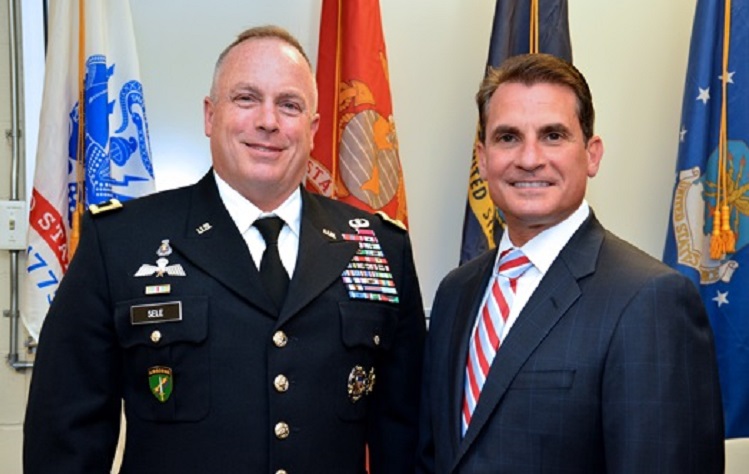Incarcerated Veterans Receive Second Chance in Suffolk County
Yaphank, NY - June 14, 2016 - An estimated 180,000 veterans are incarcerated each year nationwide, with a significant rate of re-offense according to the Bureau of Justice Statistics. Now, Suffolk County is making a push to reduce veteran recidivism and provide soldiers with the tools and the resources to appropriately cope with stressors, improve life skills, and attain educational and vocational training.

Suffolk County Sheriff Vincent DeMarco, Suffolk County Legislator Bill Lindsay, Judge John J. Toomey of the Veterans Treatment Court, New York State Senator Tom Croci, and Veteran Mentors from the Vietnam Veterans of America, Chapter 11, launched an Incarcerated Veterans Re-Entry Initiative at the Suffolk County Correctional Facility this past Friday. The program will help incarcerated veterans re-enter society with services in place to address some of the underlying causes of their contact with the justice system. Many of the jail’s incarcerated veterans suffer from PTSD and substance abuse issues, and have been involved in heavy combat situations.

The Veterans Re-Entry Program will address the re-entry needs of veterans returning to society after a period of incarceration at the Suffolk County Correctional Facility. The program will emphasize substance abuse recovery, coping with stress disorders, improving, life skills, family re-unification and vocational and educational assistance.
“I have made continuous efforts to prioritize cost effective offender rehabilitation policies that address the root cause of crime and recidivism,” said Sheriff DeMarco. “The program will provide veterans with re-entry services that will allow them to leave jail with greater opportunities, and will go a long way in meeting the needs of our veterans and our County as a whole.”
The Veterans Re-Entry Program will consist of:
- Separate Veterans Pods at the Yaphank Jail
- Increased Classification of Veterans and Program Screenings
- Standardized Schedule of Programs
- Educational & Vocational Training
- Transitional Case Management
- Coordination with the Veterans Treatment Court
- Ongoing Post-Release Case Management
- Focus on Family Reunification, Coping Skills, and Life Skills
Army Reserve Brigadier General Richard K. Sele joined the panel as the keynote speaker at the program’s launch. BG Sele is a Long Island-native who grew up in Sayville and graduated from Sayville High School in 1979. He enlisted in the Army in 1983 and has served on active duty for 24 years. Sele currently serves as the Deputy Commanding General of the 108th Training Command (IET), headquartered in Charlotte, North Carolina.
On Friday BG Sele said, “I think I see many of these same attributes in the veterans program that the Sheriff and his team are launching today. I wish them the best of luck in the program and I want to thank all of those responsible for putting this together. And a final note to our veterans that will participate in the program, I think you have a great opportunity in front of you and I wish you nothing but success in the future.”
“Suffolk County has one the highest veteran populations in the United States and we need to provide better services to meet the needs of our veterans,” said Suffolk Legislator Bill Lindsay. “Our soldiers come home with very few resources to re-enter civilian life; many begin to self-medicate with drugs or alcohol and wind up in the justice system. Today we are making strides to ensure that our veterans have the resources they need to live, work, and live freely in the home they worked so hard to protect.”
Long Island has a military veteran population of 174,000 — more than any other area in New York State. Many of Long Island’s returning veterans are Reserve and National Guard members. These veterans face many issues which can increase the likelihood of contact with the criminal justice system.
Veteran Fact Sheet
Employment:
- Gulf War II (those who served in Iraq or Afghanistan post 9/11) veterans have the highest unemployment rate of all veterans.
- “A 2011 survey of 585 National Guard veterans who served in Iraq and Afghanistan found that only a third had obtained full-time employment 45 to 60 days after returning to civilian life.”
Mental Health/PTSD and SUD:
- 16% of all Gulf War II veterans are diagnosed with Post Traumatic Stress Disorder (PTSD).
- More than 2 of 10 Veterans with PTSD also have a Substance Use Disorder (SUD).
- Almost 1 out of every 3 Veterans seeking treatment for SUD also has PTSD.
- In the wars in Iraq and Afghanistan, about 1 in 10 returning soldiers seen in VA have a problem with alcohol or other drugs.
- People with PTSD have a harder time overcoming addiction than those without it. The symptoms of withdrawal combined with the symptoms of PTSD amplify negative feelings and emotions that may lead to a relapse.
- Approximately 20 percent of service members reported binge drinking at least once a week. This rate is even higher for those with combat exposure.
- Some veterans addicted to prescriptions for pain and PTSD turn to illicit substances. Illicit drugs like heroin are often cheaper and easier to obtain than prescription painkillers.
Traumatic Brain Injury:
- From 2002 to December 2012, 253,330 service members were diagnosed with a Traumatic Brain Injury (TBI) of some kind.
- MBTI – or mild traumatic brain injury – is often described as the “signature injury” of the wars in Iraq and Afghanistan.
Suicide:
- Every 65 minutes, a military veteran commits suicide.
- 22 military veterans commit suicide every day.
- 31 percent of these suicides were veterans aged 49 and younger.
- Every month nearly 1,000 veterans attempt to take their own lives. That’s more than one attempt every half hour.
- Suicides among active duty personnel almost equal one per day, or 349 per year.
